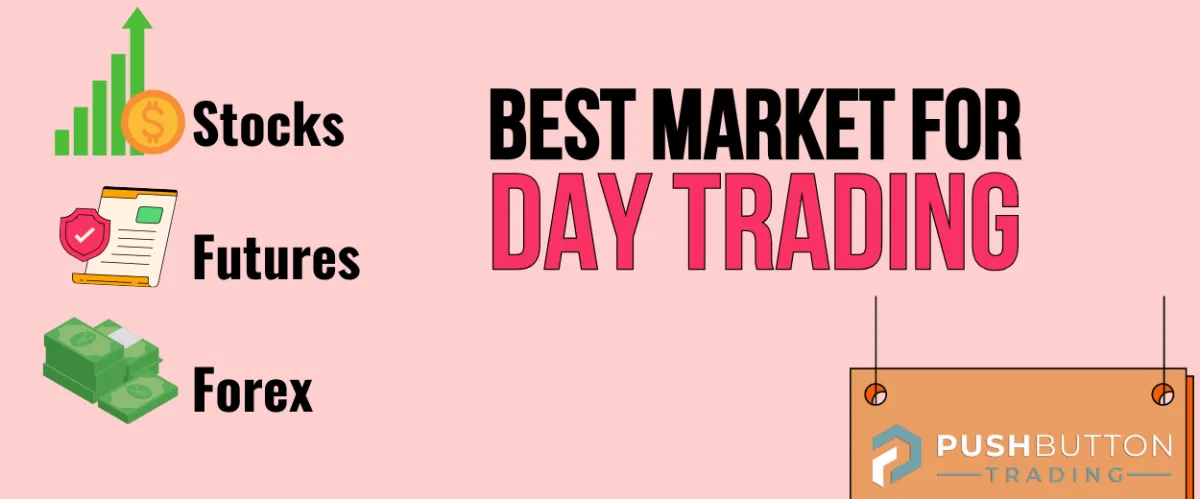
Best Market for Day Trading: Stocks vs. Futures vs. Forex
When it comes to day trading, not all markets are created equal. Stocks, futures, and forex each offer unique opportunities and challenges, and picking the right one for your trading style is crucial for success. Whether you’re looking for high volatility, leverage, or the security of regulated markets, understanding the differences between these market types will help you make informed decisions and avoid costly mistakes.
Let’s break down the advantages & challenges of trading stocks, futures, and forex, so you can decide which day trading market best aligns with your trading strategy.
Best Market for Your Day Trading Strategy
Below I compared stocks vs. futures vs. forex and listed out their advantages & challenges which will help you choose the best day trading market as per your trading strategy.
1. Stock Market: Familiarity Meets Flexibility

The stock market is where traders buy and sell shares of publicly traded companies like Apple, Tesla, or Amazon. Day trading stocks can be appealing due to their transparency and familiarity. Most people understand what stocks represent, making them an accessible entry point for beginner traders.
Advantages of Day Trading Stocks:
Familiarity: Stocks are often easier to understand because they represent ownership in companies we know.
Liquidity: Stocks like Apple or Microsoft have high liquidity, meaning it’s easy to enter and exit trades without large price fluctuations.
Regulation: The stock market is highly regulated, offering protections for traders and investors.
Challenges of Day Trading Stocks:
Capital Requirements: In the U.S., the Pattern Day Trader (PDT) rule requires you to have at least $25,000 in your account to make more than three-day trades in a rolling five-day period. This can be a significant hurdle for new traders.
Slower Moves: While stocks can be volatile, they often move slower compared to futures or forex markets, requiring more patience or larger capital for big gains.
2. Futures Market: High Leverage and Volatility
The futures market deals in contracts that obligate the buyer to purchase (or seller to sell) an asset at a predetermined price at a future date. Popular futures for day traders include contracts for commodities (like oil or gold), indices (like the E-mini S&P 500), and even currencies.
Advantages of Day Trading Futures:
Leverage: Futures markets offer significant leverage, allowing traders to control large positions with a relatively small amount of capital. This means potential for larger gains with a smaller account.
Extended Trading Hours: Futures markets often trade nearly 24/7, providing flexibility for traders in different time zones or those with non-traditional schedules.
Diversification: Futures markets span commodities, indices, bonds, and currencies, offering traders a broad range of assets to choose from.
Challenges of Day Trading Futures:
Volatility: While volatility can present great profit opportunities, it also increases risk for futures traders. Futures markets can see sharp price movements, which might be difficult to manage without a strong risk strategy.
Margin Calls: Leverage is a double-edged sword. While it amplifies profits, it also amplifies losses and margin calls are common if a position moves too far against you.
3. Forex Market: The World of Currency Pairs
The forex market (foreign exchange) is the largest financial market in the world, where traders buy and sell currencies. Day traders in the forex market speculate on changes in currency exchange rates, such as the EUR/USD or GBP/JPY.
Advantages of Day Trading Forex:
High Liquidity: The forex market is incredibly liquid, with trillions of dollars traded daily. This means you can always find someone to take the other side of your trade.
Leverage: Like futures, forex offers high leverage, often as much as 50:1 (depending on the broker and jurisdiction). This allows traders to amplify their position sizes with relatively small amounts of capital.
24-Hour Market: Forex is open 24 hours a day, five days a week, meaning you can trade across different sessions, from the London open to the New York close.
Challenges of Day Trading Forex:
Overwhelming Choice of Pairs: While forex provides ample opportunities, the sheer number of currency pairs can overwhelm beginners. Focusing on major pairs like EUR/USD or USD/JPY can help.
Complex Movements: Currency prices are often influenced by macroeconomic factors, such as interest rates and geopolitical events, which can be harder to predict or react to for novice traders.
Broker Fees: While forex brokers often advertise "no commission" trading, they make money on the spread (the difference between the buy and sell price), which can add up over time.
What Should You Choose?
Each market has its strengths and weaknesses, and there’s no one-size-fits-all answer when it comes to choosing between stocks, futures, and forex. The best market for your day trading strategy depends on your goals, risk tolerance, capital, and schedule.
Consider the Following:
Do you have a large capital base? If so, the stock market might be a good fit. You’ll avoid PDT restrictions and can take advantage of stable, slow-moving opportunities.
Looking for fast-paced action with high leverage? Futures trading offers higher volatility and greater leverage than stocks, but it requires strict risk management to avoid large losses.
Need flexibility in your trading hours? Forex markets operate around the clock, making them ideal for traders in different time zones or with non-traditional work schedules.
Conclusion: Choose the Market That Matches Your Strategy
The key to successful day trading is choosing the market that aligns with your strategy, capital, and personality. Stocks may offer the security and familiarity that new traders need, while futures and forex markets provide the leverage and volatility that more experienced traders crave. Whichever market you choose, understanding its dynamics and managing risk is essential for long-term success.
Want to dive deeper into these markets? Subscribe to our trading blog for more expert tips and insights into day trading strategies, psychology, and tools for consistency.




